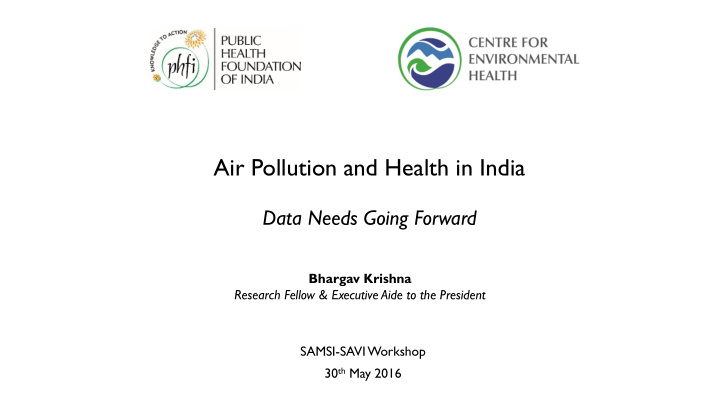



Air Pollution and Health in India Data Needs Going Forward Bhargav Krishna Research Fellow & Executive Aide to the President SAMSI-SAVI Workshop 30 th May 2016
Identifying the Needs 1.Expanding the evidence base on health impacts 2.Identifying and implementing evidence-informed policy 3.Monitoring progress on international commitments
To Expand the Evidence Base • First of its kind report by a Ministry of Health • Focused on reduction of total exposure • Collated the best available evidence in the Indian context on exposure and health impacts
To Expand the Evidence Base • Most studies deficient in exposure or outcome assessment • Most studies based on coarse PM (RSPM, SPM, PM 10 ) • Little to no examination of: o Cardio-metabolic impacts o Prenatal/early childhood exposures o Neurocognitive effects • Most studies either time-series or cross-sectional o Long-term exposure? • Microenvironment profiles o E.g. in-transit/in-vehicle exposures
To Develop Evidence-Informed Policy • Air pollution finally on the radar • Driven by judicial action • Political will lacking • Developmental trade-offs? • Incoherent response • E.g. Odd-Even • New TPP Standards • Focus still very Delhi-centric • Tier 2 & 3 cities completely ignored
To Develop Evidence-Informed Policy • Compelling evidence needed on sector-specific impacts • More data needed on contribution of localized sources to exposure (e.g. waste burning, small industries) • Cost-Benefit analysis of major policy actions • Shift to EURO VI fuel standards • Ending diesel subsidies • Evidence base outside Delhi and the metros • Establishing sentinel sites for surveillance • Critically polluted areas – tools to monitor exposures and evaluate health impacts
To Track Progress on International Commitments • New commitments made under the Sustainable Development Goal Framework • Questions around data availability, quality and reporting timelines • Target 3.9 By 2030, substantially reduce the number of deaths and illnesses from hazardous chemicals and air, water and soil pollution and contamination. • Indicator: Mortality rate attributed to household and ambient air pollution • Target 11.6 By 2030, reduce the adverse per capita environmental impact of cities, including by paying special attention to air quality and municipal and other waste management • Indicator: Annual mean levels of fine particulate matter (i.e. PM2.5 and PM10) in cities (population weighted) • Expanded continuous monitoring network; low cost monitoring??
Recommend
More recommend